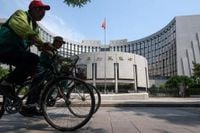China’s central bank, the People’s Bank of China (PBOC), has signaled a cautious approach to monetary policy, holding back from aggressive measures such as interest rate cuts, even as the country’s economy endured its weakest month so far in 2025. The PBOC’s quarterly policy report, released late on August 15, 2025, outlined a commitment to a “moderately loose” monetary stance but stopped short of promising immediate broad-based stimulus. This decision comes on the heels of disappointing economic data that confirmed a marked slowdown in domestic demand, raising questions about the central bank’s strategy for steering the world’s second-largest economy through choppy waters.
According to both Bloomberg and KEY Difference Wire, the PBOC’s latest report emphasized a thorough execution of its current policies, with a focus on targeted support rather than sweeping interventions. The bank’s language, analysts at Citigroup and Goldman Sachs noted, indicates a lack of urgency for major easing moves like rate cuts or reductions in the reserve requirement ratio (RRR)—at least for now. Instead, the central bank appears intent on deploying selective measures aimed at specific sectors or issues within the economy.
“Its emphasis on executing existing policies and targeted easing signaled limited appetite for broad-based monetary easing,” said Chen Xinquan, an economist at Goldman Sachs, as reported by Bloomberg. This sentiment was echoed by Citigroup’s Yu Xiangrong, who wrote in a Sunday report that “structural policies could be a more important venue for the PBOC in the next few months compared with broad-based rate or RRR cuts.”
July 2025 proved to be a particularly rough month. The economy slowed sharply, with domestic policies designed to cut overcapacity and the impact of rising tariffs squeezing production and trade. Infrastructure investment faltered, and Chinese consumers—wary of economic uncertainty—kept their spending in check. Private sector demand, a key engine of growth, stalled.
Despite these headwinds, China’s economy still managed a 5.3% year-on-year GDP growth rate in the first half of 2025. That figure is just about enough to keep policymakers in Beijing optimistic about hitting their official annual growth target of around 5%. This sense of cautious confidence seems to underpin the PBOC’s reluctance to reach for the rate cut lever prematurely, even as the economic outlook clouds over.
The PBOC’s report also addressed persistent deflationary concerns that have hovered over China for more than two years. While headline inflation remains subdued, the central bank noted some improvement in the core consumer price index—an important metric that excludes volatile items like food and energy. The PBOC pointed to initiatives such as a crackdown on “disorderly” pricing and renewed efforts to boost consumer spending as steps that should help nudge inflation back toward healthier levels.
Yet, inflation isn’t the only worry on the central bank’s mind. The PBOC also flagged risks related to the stability of China’s financial system. In its quarterly report, the bank pledged to prevent funds from idly circulating within the financial system—a clear sign of concern about potential financial loopholes and systemic risks. As Bloomberg reported, this caution is partly why the PBOC is resisting the temptation to unleash broad monetary easing, which could inadvertently fuel speculation or create new vulnerabilities.
“Any additional stimulus could lead to arbitrage and speculation, something Beijing is now actively trying to block,” noted Goldman Sachs, according to KEY Difference Wire. The central bank’s measured approach reflects a delicate balancing act: providing enough liquidity to support growth, while keeping a tight grip on financial stability.
In January 2025, the PBOC established a macro-prudential and financial stability committee in response to calls from top officials for greater oversight. The bank’s mandate has expanded over the past few years, especially regarding China’s volatile property and stock markets. Earlier in 2025, the PBOC even backed the creation of a quasi-stabilization fund to buy equities and calm stock market swings, underscoring its willingness to intervene directly when needed.
For now, though, the central bank’s message is clear: patience and precision trump panic and haste. The PBOC’s current stance suggests it is betting on the resilience of China’s economic fundamentals—and the effectiveness of its targeted interventions—to weather the present storm without resorting to all-out monetary stimulus. Still, few believe the PBOC will stand pat indefinitely if the slowdown deepens.
Most analysts, including those at Citigroup and Goldman Sachs, expect that the central bank could eventually move to cut interest rates by 10 to 20 basis points and reduce the RRR by 50 basis points before the year’s end, should economic conditions deteriorate further. There is also speculation, according to KEY Difference Wire, about the potential for a 500 billion yuan (roughly $70 billion) quasi-fiscal stimulus package to be deployed, aimed at directly shoring up demand.
All of this comes against a backdrop of complex policy trade-offs. On the one hand, too much stimulus could undermine efforts to rein in financial risks and promote sustainable growth. On the other, holding back could risk letting the slowdown gather momentum, with unpredictable consequences for employment, investment, and social stability. It’s a classic central banker’s dilemma, and the stakes are high for China’s leadership as they navigate a year of economic uncertainty.
For now, the PBOC’s approach is to “thoroughly” enact its moderately loose monetary policy, as pledged in its quarterly report, while closely monitoring the evolving economic landscape. The bank’s focus on targeted support and financial system stability reflects both confidence in China’s underlying strengths and wariness of overreaching. Whether this strategy will prove sufficient—or whether more decisive action will be required later in the year—remains to be seen.
As the world watches China’s economic experiment unfold, one thing is certain: the PBOC is playing the long game, betting that patience and precision will win out over panic. Only time will tell if that bet pays off.

